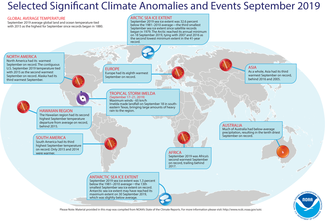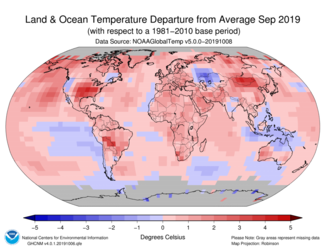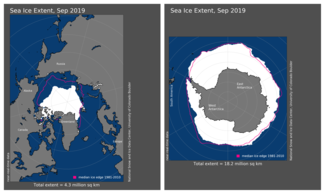September tied as warmest for the globe

The global land and ocean surface temperature departure from average for September 2019 tied with 2015 as the highest for the month of September in the 140-year NOAA global temperature dataset record, which dates back to 1880. The year-to-date temperature for 2019 was the second warmest January–September on record.
This monthly summary, developed by scientists at NOAA National Centers for Environmental Information, is part of the suite of climate services NOAA provides to government, business, academia, and the public to support informed decision-making.
September Temperature
The September temperature across global land and ocean surfaces was 1.71°F above the 20th century average of 59.0°F and tied with 2015 as the highest for September in the 1880–2019 record.
- The 10 warmest Septembers have all occurred since 2005, with the last five years (2015–2019) being the five warmest Septembers on record.
- September 2019 also marks the 43rd consecutive September and the 417th consecutive month with temperatures, at least nominally, above the 20th century average.
- September 2019 also tied with September 2015 and June 2019 as the 14th highest monthly temperature departure on record.
- The Northern Hemisphere, as a whole, also had its warmest September on record at 2.23°F above average, surpassing the previous record set in 2016 by +0.05°F. The five highest September Northern Hemisphere land and ocean surface temperature departures from average have occurred since 2015.
- The Southern Hemisphere land and ocean surface temperature was 1.15°F above average and was the seventh warmest September on record.
- Record warm September temperatures were present across parts of the North and Western Pacific Ocean, the Barents Sea, the south-central contiguous United States, northern Canada, the Atlantic and Indian oceans, the Middle East, Mongolia and northern China, and Africa. No land or ocean areas had record cold September temperatures.
The September globally averaged land surface temperature was 2.56°F above the 20th century average of 53.6°F and the highest September land temperature in the 140-year record. September 2016 is now the second highest September global land temperature departure from average at 2.48°F.
-
The most notable warm temperature departures from average were observed across much of Alaska, western Canada, the southern and southeastern contiguous United States, the North Pacific Ocean as well as the Bering and Barents seas, central South America, Mongolia, and northern Russia, where temperatures were at least 3.6°F or higher. The most notable cooler-than-average temperatures were present across parts of western Russia and Indonesia, where temperatures were at least 1.8°F below average or cooler.
-
Regionally, North America, South America, Africa, Asia, the Gulf of Mexico, and the Hawaiian region had a September temperature departure from average that ranked among the top three warmest Septembers on record. Of note, North America had its warmest September at 3.10°F above average, surpassing the previous record set in 1998 by just 0.02°F.
-
The Gulf of Mexico region also had its warmest September on record at 1.78°F above average. This was 0.07°F higher than the previous record set in 2016.
The September globally averaged sea surface temperature was 1.40°F above the 20th century monthly average of 61.1°F, tying with 2016 as the second highest global sea surface temperature for September on record. September 2015 was warmer at +1.51°F. Compared to all months, the global ocean-only temperature departure tied with September 2016 and July 2017 and as the 18th highest monthly temperature departure in the 1677 monthly record.
Sea Ice
The Arctic sea ice extent for September 2019 was the third lowest on record at 807,000 square miles (32.6%) below the 1981–2010 average and 290,000 square miles above the record low September sea ice extent set in 2012, according to an analysis by the National Snow and Ice Data Center (NSIDC) using data from NOAA and NASA. The Arctic reached its annual minimum sea ice extent of 1.60 million square miles on 18 September 2019, marking the end of the melt season. The Arctic sea ice minimum extent for 2019 tied with 2007 and 2016 as the second lowest minimum extent in the 41-year record. The record minimum of 1.31 million square miles was set on 17 September 2012. According to NSIDC, the 13 lowest annual minimum extents have occurred in the last 13 years.
The September 2019 Antarctic sea ice extent was 100,000 square miles (1.3%) below the 1981–2010 average and was the 13th smallest September extent in the 41-year record. The Antarctic typically reaches its annual maximum in late September or early October. According to NSIDC, Antarctic sea ice extent may have reached its maximum extent on 30 September 2019 at 7.10 million square miles, which is slightly below the 1981–2010 average.
Year-to-date (January–September 2019)
The year-to-date temperature across global land and ocean surfaces was 1.69°F above the 20th century average of 57.5°F — the second highest for January–September in the 140-year record. Only January–September 2016 was warmer (+1.91°F).
-
The most notable warm temperature departures from average were present across much of Alaska, western Canada, and central Russia, where temperatures were at least +2.7°F above average. Meanwhile, the most notable cool temperature departures from average were present across much of the north-central contiguous United States and southern Canada, where temperatures were at least 1.8°F below average or cooler.
-
Record warm January–September temperatures were observed across much of the southern half of Africa, western Indian Ocean, Madagascar, and across parts of Australia, the western Pacific Ocean, New Zealand, Asia, the Atlantic Ocean, and North and South America. No land or ocean areas had record cold temperatures during January–September 2019.
-
The Northern Hemisphere land and ocean surface temperature tied with 2017 as the second highest January–September on record at 2.03°F above average. Only January–September of 2016 was warmer (+2.36°F).
-
The Southern Hemisphere's January–September 2019 land and ocean surface temperature was 1.35°F above average–also the second warmest such period on record, behind 2016 by 0.11°F.
-
Regionally, South America, Europe, Africa, Asia, Oceania, the Gulf of Mexico, and the Hawaiian region had a January–September temperature average that ranked among the four highest such periods on record.
The year-to-date globally averaged land surface temperature was 2.54°F above the 20th century average of 48.7°F. This value was the third highest for January–September on record, behind 2016 (+3.02°F) and 2017 (+2.61°F).
The year-to-date globally averaged sea surface temperature was the second highest for January–September in the 1880–2019 record at 1.39°F above the 20th century average of 61.1°F, trailing behind January–September 2016 (+1.49°F).
For a more complete summary of climate conditions and events, see our September 2019 Global Climate Report.









